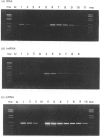Abstract
We previously isolated and characterized a human myeloma cell line overproducing ornithine decarboxylase (ODC) due to gene amplification [Leinonen, Alhonen-Hongisto, Laine, Jänne & Jänne (1987) Biochem. J. 242, 199-203]. We have now employed the PCR combined with reverse transcription to determine semiquantitatively ODC gene dosage and the amounts of heterogeneous nuclear (hn) RNA and of mature mRNA of the enzyme in parental and alpha-difluoromethylornithine-resistant human myeloma cells. Experiments with dilution series revealed that the ODC gene copy number and the amount of both hnRNA and mRNA were increased to the same extent (about 100-fold) in the resistant cells. Similar dot-blot analyses of ODC-specific genomic DNA and total RNA indicated that the ODC gene copy number was increased by a factor of 380 and the amount of ODC mRNA by a factor of 700. Our results indicate that the PCR combined with reverse transcription is at least as useful as blot analyses to give semiquantitative assessment of the amounts of specific DNA or RNA sequences. In addition, the use of the PCR enables the analysis of minute sample amounts in extremely short time.
Full text
PDF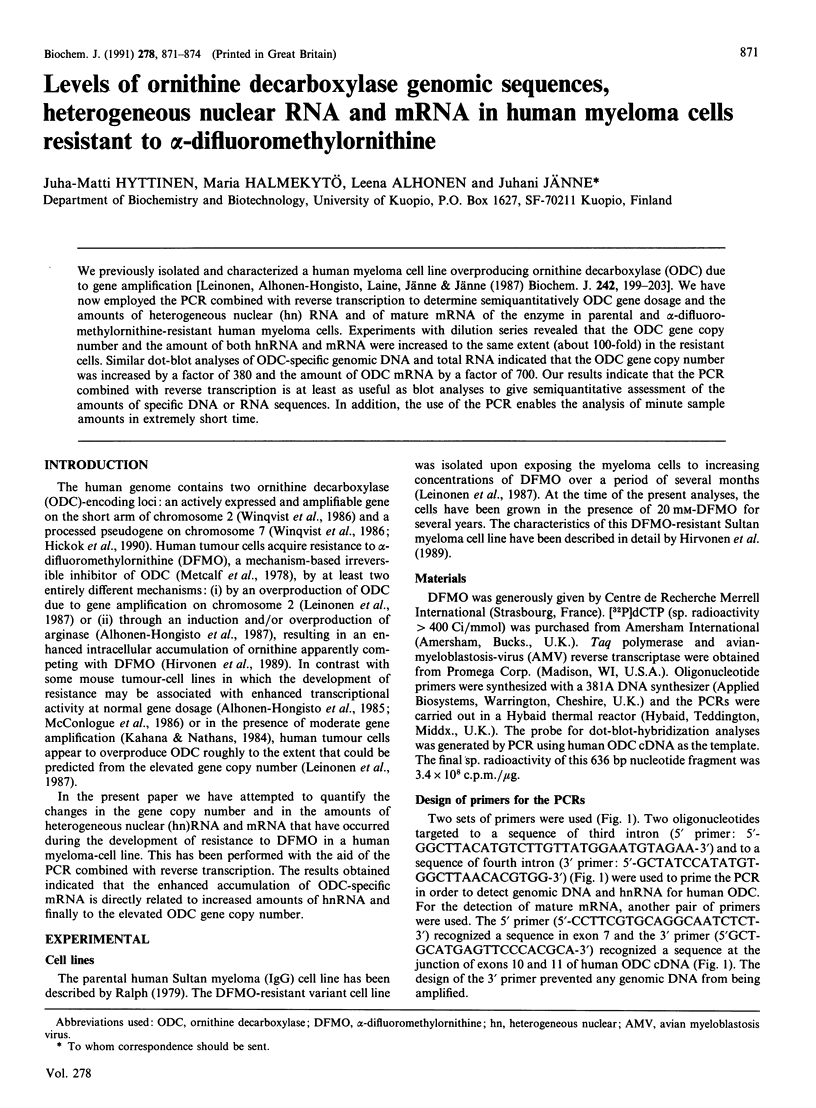
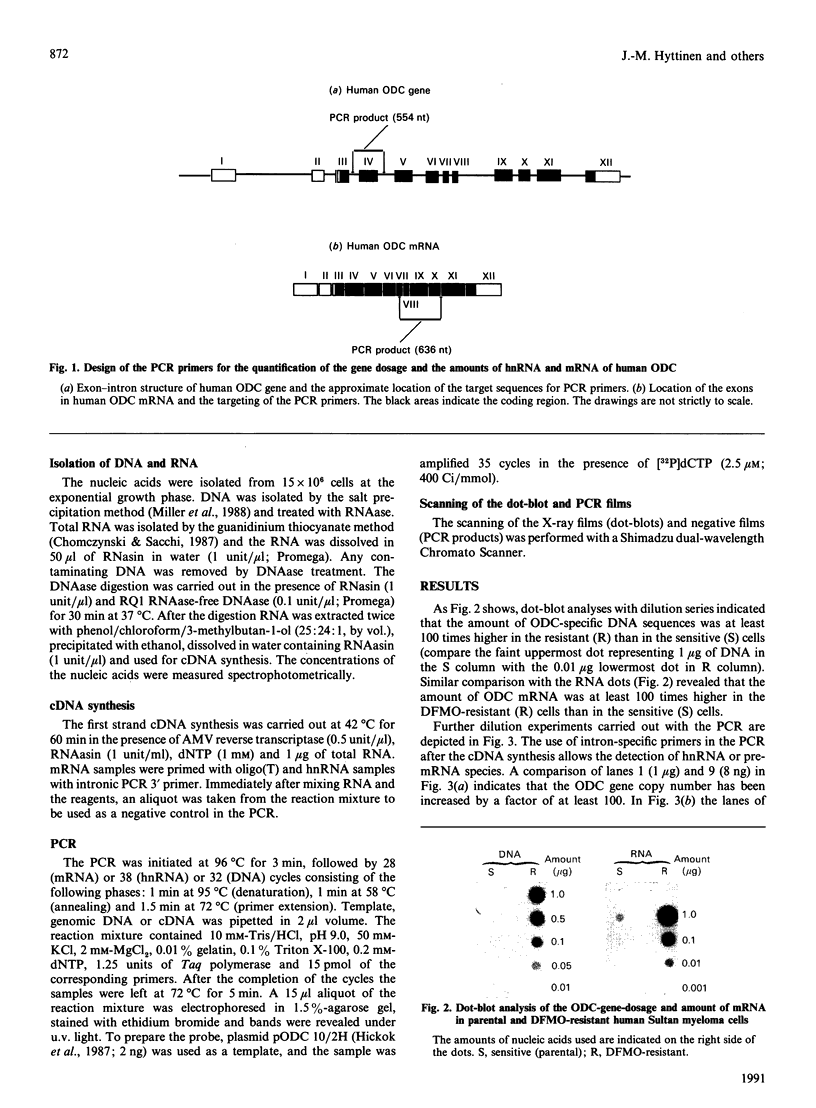
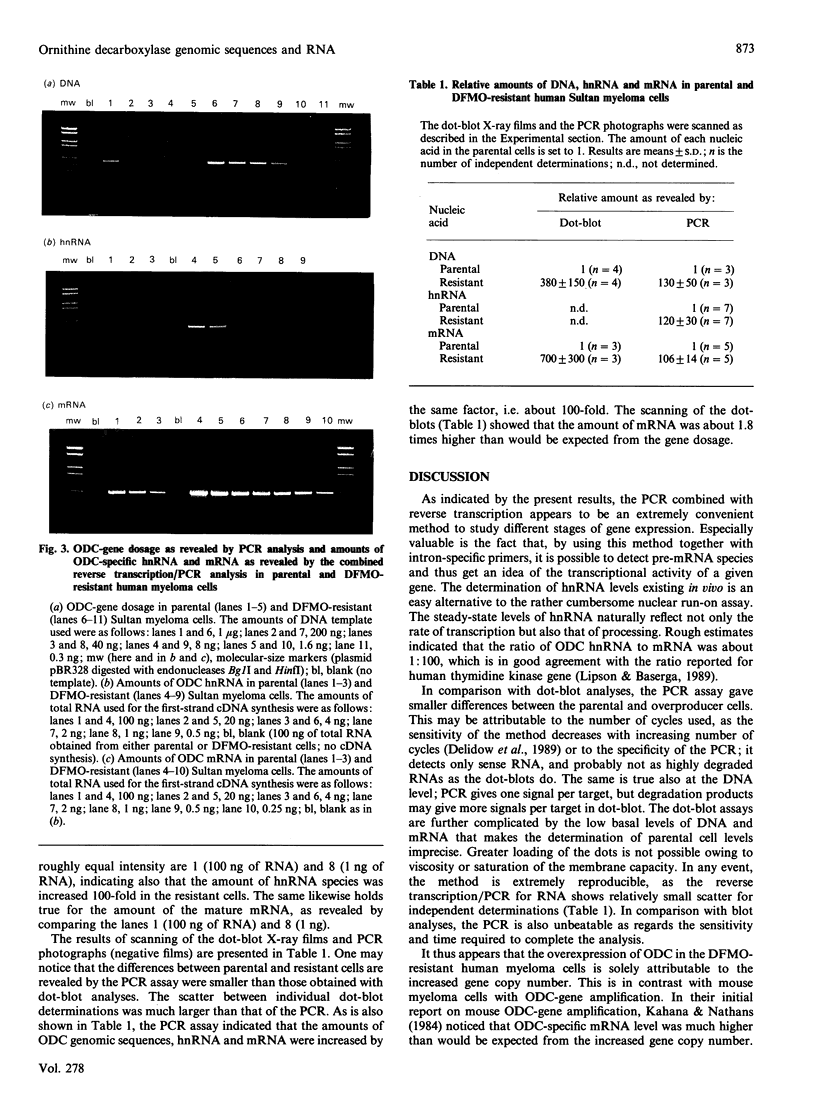
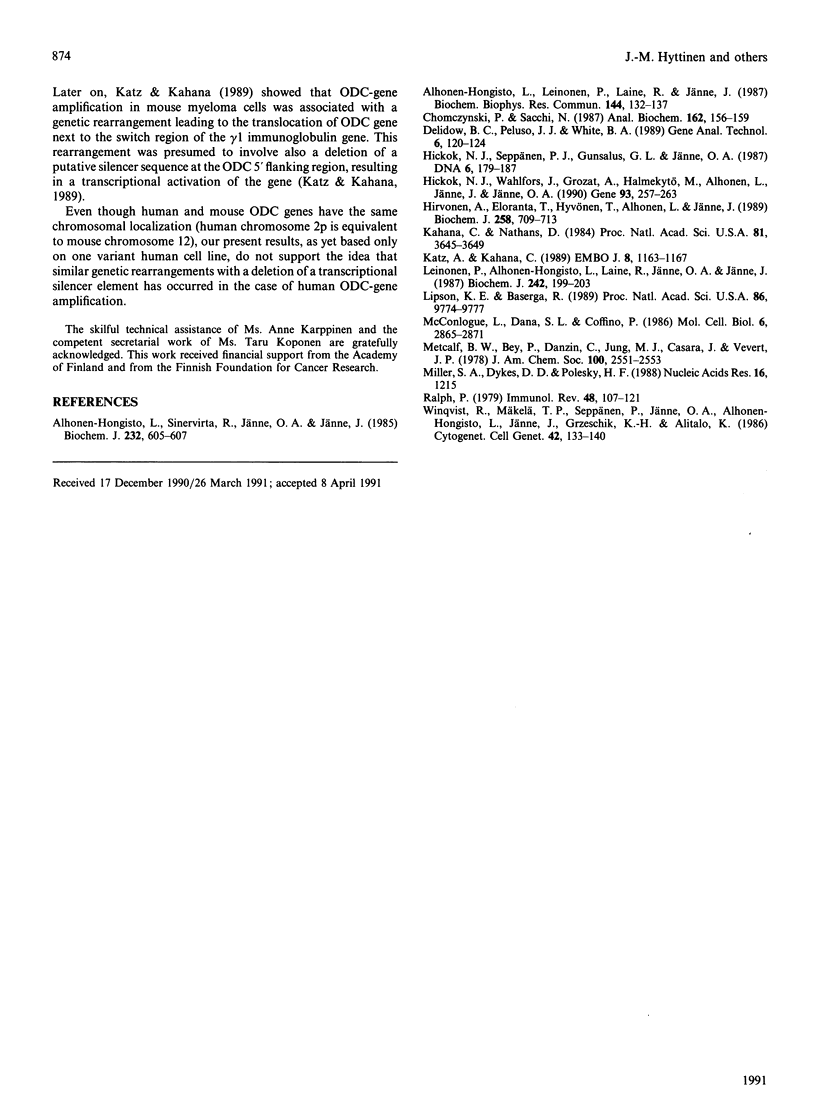
Images in this article
Selected References
These references are in PubMed. This may not be the complete list of references from this article.
- Alhonen-Hongisto L., Leinonen P., Laine R., Jänne J. Human myeloma cells acquire resistance to difluoromethylornithine without overproducing ornithine decarboxylase. Biochem Biophys Res Commun. 1987 Apr 14;144(1):132–137. doi: 10.1016/s0006-291x(87)80485-0. [DOI] [PubMed] [Google Scholar]
- Alhonen-Hongisto L., Sinervirta R., Jänne O. A., Jänne J. Gene expression of ornithine decarboxylase in L1210 leukaemia cells exposed to DL-2-difluoromethylornithine in the presence of cadaverine. Biochem J. 1985 Dec 1;232(2):605–607. doi: 10.1042/bj2320605. [DOI] [PMC free article] [PubMed] [Google Scholar]
- Chomczynski P., Sacchi N. Single-step method of RNA isolation by acid guanidinium thiocyanate-phenol-chloroform extraction. Anal Biochem. 1987 Apr;162(1):156–159. doi: 10.1006/abio.1987.9999. [DOI] [PubMed] [Google Scholar]
- Delidow B. C., Peluso J. J., White B. A. Quantitative measurement of mRNAs by polymerase chain reaction. Gene Anal Tech. 1989 Nov-Dec;6(6):120–124. doi: 10.1016/0735-0651(89)90002-2. [DOI] [PubMed] [Google Scholar]
- Hickok N. J., Seppänen P. J., Gunsalus G. L., Jänne O. A. Complete amino acid sequence of human ornithine decarboxylase deduced from complementary DNA. DNA. 1987 Jun;6(3):179–187. doi: 10.1089/dna.1987.6.179. [DOI] [PubMed] [Google Scholar]
- Hickok N. J., Wahlfors J., Crozat A., Halmekytö M., Alhonen L., Jänne J., Jänne O. A. Human ornithine decarboxylase-encoding loci: nucleotide sequence of the expressed gene and characterization of a pseudogene. Gene. 1990 Sep 14;93(2):257–263. doi: 10.1016/0378-1119(90)90233-h. [DOI] [PubMed] [Google Scholar]
- Hirvonen A., Eloranta T., Hyvönen T., Alhonen L., Jänne J. Characterization of difluoromethylornithine-resistant mouse and human tumour cell lines. Biochem J. 1989 Mar 15;258(3):709–713. doi: 10.1042/bj2580709. [DOI] [PMC free article] [PubMed] [Google Scholar]
- Kahana C., Nathans D. Isolation of cloned cDNA encoding mammalian ornithine decarboxylase. Proc Natl Acad Sci U S A. 1984 Jun;81(12):3645–3649. doi: 10.1073/pnas.81.12.3645. [DOI] [PMC free article] [PubMed] [Google Scholar]
- Katz A., Kahana C. Rearrangement between ornithine decarboxylase and the switch region of the gamma 1 immunoglobulin gene in alpha-difluoromethylornithine resistant mouse myeloma cells. EMBO J. 1989 Apr;8(4):1163–1167. doi: 10.1002/j.1460-2075.1989.tb03487.x. [DOI] [PMC free article] [PubMed] [Google Scholar]
- Leinonen P., Alhonen-Hongisto L., Laine R., Jänne O. A., Jänne J. Human myeloma cells acquire resistance to difluoromethylornithine by amplification of ornithine decarboxylase gene. Biochem J. 1987 Feb 15;242(1):199–203. doi: 10.1042/bj2420199. [DOI] [PMC free article] [PubMed] [Google Scholar]
- Lipson K. E., Baserga R. Transcriptional activity of the human thymidine kinase gene determined by a method using the polymerase chain reaction and an intron-specific probe. Proc Natl Acad Sci U S A. 1989 Dec;86(24):9774–9777. doi: 10.1073/pnas.86.24.9774. [DOI] [PMC free article] [PubMed] [Google Scholar]
- McConlogue L., Dana S. L., Coffino P. Multiple mechanisms are responsible for altered expression of ornithine decarboxylase in overproducing variant cells. Mol Cell Biol. 1986 Aug;6(8):2865–2871. doi: 10.1128/mcb.6.8.2865. [DOI] [PMC free article] [PubMed] [Google Scholar]
- Miller S. A., Dykes D. D., Polesky H. F. A simple salting out procedure for extracting DNA from human nucleated cells. Nucleic Acids Res. 1988 Feb 11;16(3):1215–1215. doi: 10.1093/nar/16.3.1215. [DOI] [PMC free article] [PubMed] [Google Scholar]
- Ralph P. Functional subsets of murine and human B lymphocyte cell lines. Immunol Rev. 1979;48:107–121. doi: 10.1111/j.1600-065x.1979.tb00300.x. [DOI] [PubMed] [Google Scholar]
- Winqvist R., Mäkelä T. P., Seppänen P., Jänne O. A., Alhonen-Hongisto L., Jänne J., Grzeschik K. H., Alitalo K. Human ornithine decarboxylase sequences map to chromosome regions 2pter----p23 and 7cen----qter but are not coamplified with the NMYC oncogene. Cytogenet Cell Genet. 1986;42(3):133–140. doi: 10.1159/000132266. [DOI] [PubMed] [Google Scholar]




